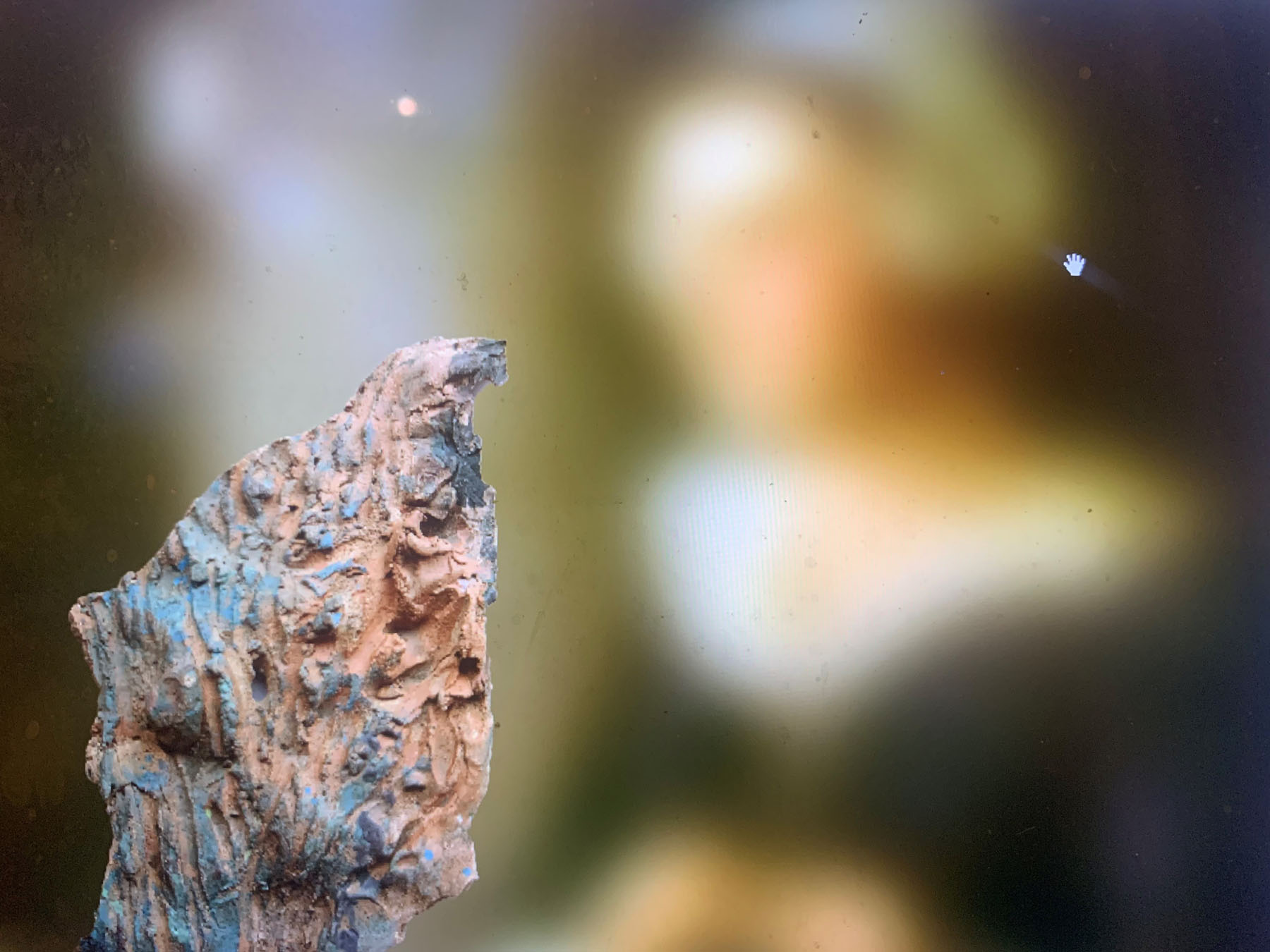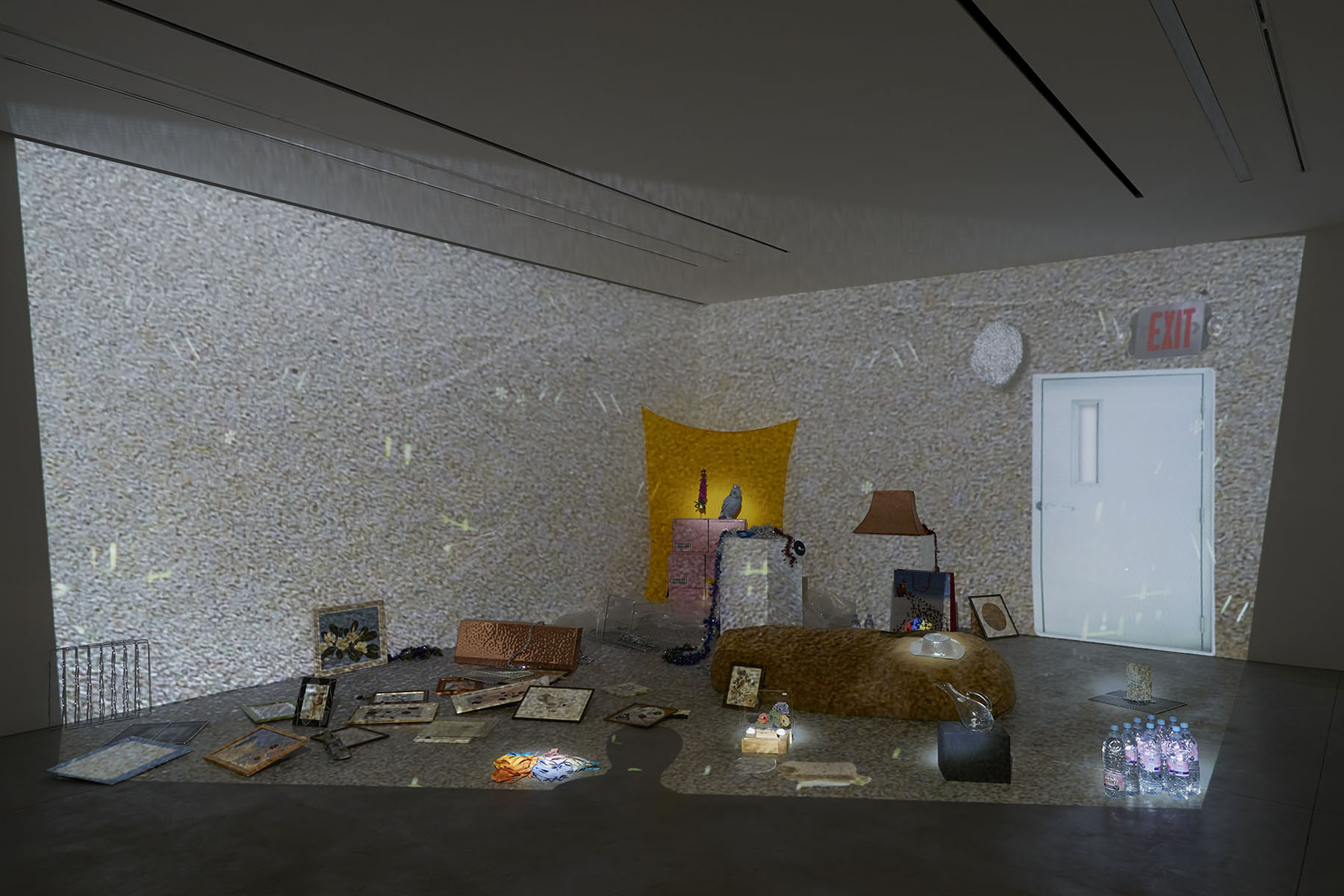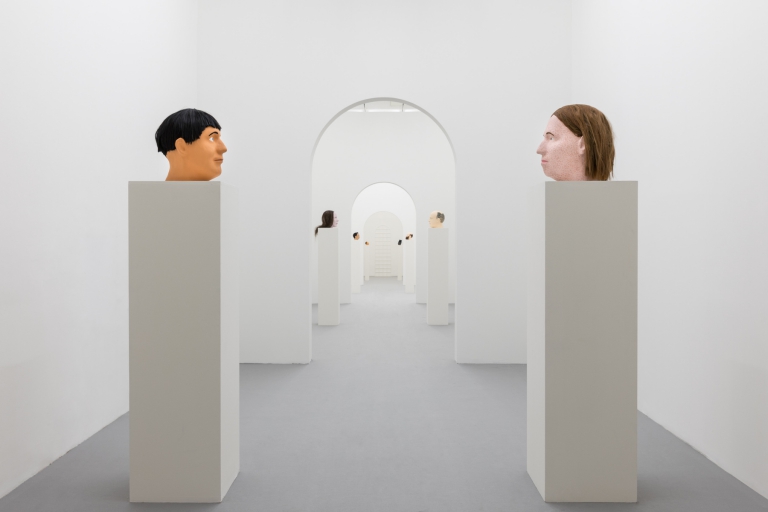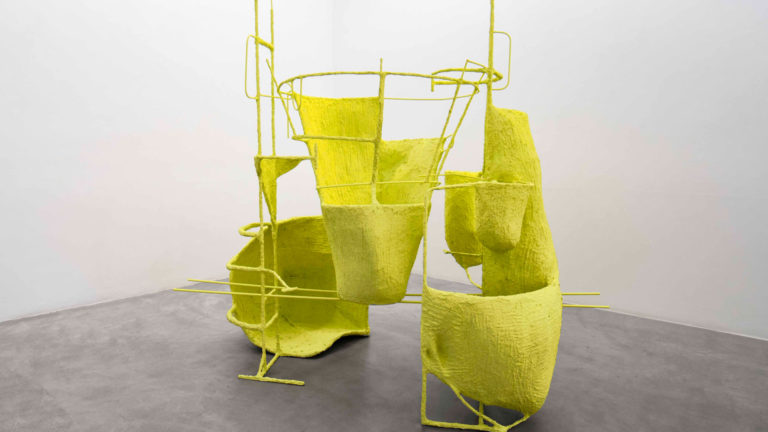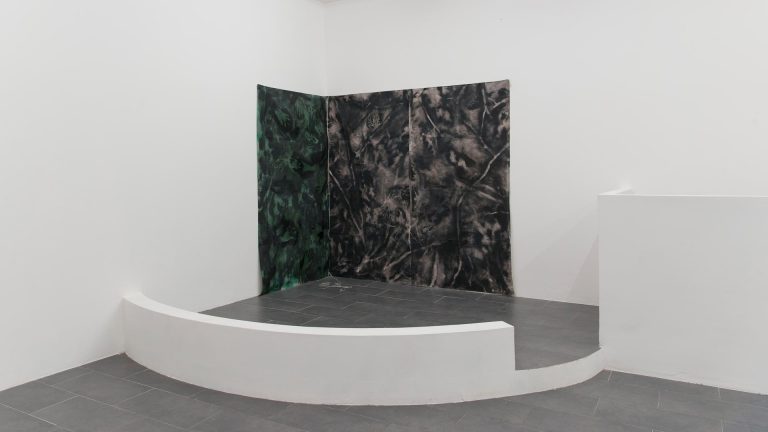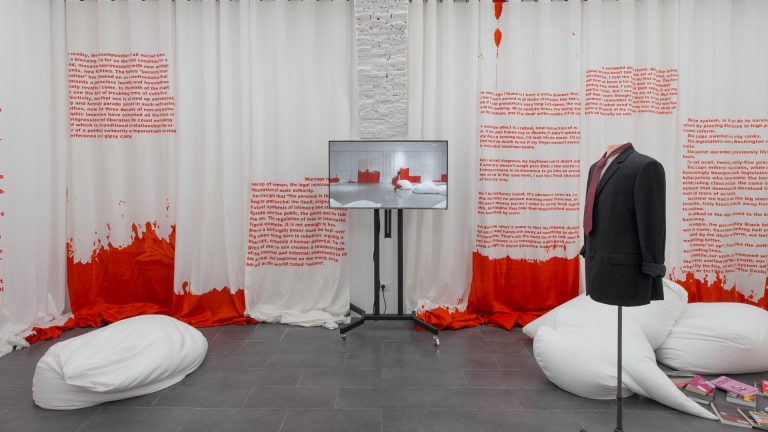Artist: Trisha Baga
Exhibition title: the eye, the eye and the ear
Curated by: Lucia Aspesi and Fiammetta Griccioli
Venue: Pirelli HangarBicocca, Milan, Italy
Date: February 20, 2020 – January 10, 2021
Photography: all images copyright and courtesy of the artist and Pirelli HangarBicocca
Pirelli HangarBicocca presents Trisha Baga’s solo exhibition “the eye, the eye and the ear”, running from 20 February to 19 July 2020 and comprising of video installations and ceramic sculptures, which form a sequence of unusual and thought provoking narratives: from science-fiction and the popstar Madonna to ancient myths and digital devices such as Alexa Echo Dot.
Trisha Baga, an American of Filipino origin, is one of the most innovative artists and video-makers of her generation, combining different languages and other media, drawing from television and film imagery along with home movies. She grapples with such themes as gender identity, relations between the real and the digital world as well as technological evolution, in order to disclose a different perspective of our contemporary imagination.
The Artist
From the second half of the 2000s Trisha Baga (b.1985 in Venice, Florida, currently lives and works in New York City) developed her practice through performance and video works that began with a careful reflection on the human body and language and their mutual transformation over time. By blending fragments of popular culture, humorous situations, and contemporary forms of communication, the artist has gradually replaced her own body with found or adapted objects that become part of her installations, privileging 3D technology as a way of expanding the video projections to occupy the exhibition space itself. In fact, the projections often incorporate staged objects to create an interplay of volumes and shadows, stratifying the physical space into numerous visual and sound layers. Among the protagonists of these filmic landscapes, the objects become part of the narrative, in which apparently unconnected episodes alternate with more structured instances that challenge the observer’s attention.
Taking her cue from today’s rapidly transforming technology and how it affects the society around us, Trisha Baga ironically deconstructs the entrenched schemes and elements of mass culture and mixes them in a very diverse corpus of work. Thus, we see the singer Madonna cohabiting with the figure of the artist, as in Madonna y El Niño (2010); or videos inspired by sci-fi movies projected over portraits of Baga’s family members; while electronic devices that have now entered our daily lives such as Amazon’s Alexa Echo Dot become protagonists, as in Mollusca & The Pelvic Floor (2018).
The human body and its representational fragmentation are constants in Baga’s work. She uses them to explore ideas about gender identity and the relationship between the individual and society at large, conducting an inquiry into the imagery of post-colonial societies and themes tied to the psychological effects of globalisation. In her videos, she often captures these aspects through syncopated editing, bringing together diverse geographic locations and environments, juxtaposed in rapid and fluid sequences. At the same time, fragments of incoherent narratives and found footage are accompanied by frames and screenshots from computer screens, cursors and pop-up windows that unveil their ephemeral and malleable nature.
Alongside video, Baga’s work incorporates both painting and ceramics. In particular, her ceramics often seem to express a hypothetical primordial rendering of the reality that surrounds us – including printers, microscopes, cameras, telephones –whilst her paintings of desert-like landscapes composed of sesame seeds on wooden surfaces, depict material version of the pixelated images of the videos.
The Exhibition
“the eye, the eye and the ear”, curated by Lucia Aspesi and Fiammetta Griccioli, is the first institutional show of the artist in Italy. The exhibition brings together five video installations investigating the co-dependent evolution of the body with the constantly updating image technology. It covers fifteen years of production, from her first piece There’s No “I” in Trisha (2005-2007/2020), conceived as a TV sitcom that questions the gender stereotypes of all the various characters whose roles Trisha Baga plays; to the more recent work 1620 (2020) produced specifically for this show. Like a mise en abyme, the exhibition meanders through the various media which have characterized Baga’s career, ranging from VHS cassettes and DVDs to 3D devices, and is deeply rooted in her performative practice. Furthermore, the artist presents a rich selection of ceramic works produced since 2015 and six pieces from the series Seed Paintings (2017), composed of sesame seeds and foam mounted on wooden panels of varying sizes.
The show’s display hints at the aesthetics commonly found in natural history museums, not only in its style of presentation, but also by using an unusual classification system that intertwines the idea of the fossil with high-tech devices such as today’s virtual personal assistants, thus creating a sort of temporal short-circuit. Through her ironical and witty perspective Baga focuses on the excessive reliance and hopes we put on technology, staging in her work its most fragile and failing aspects. The show’s title “the eye, the eye and the ear”, individualizes and fragments the bodily senses that are active while experiencing the exhibition, in which the visual effects replicate and dialogue with the sounds in such a way that the narrative becomes a living organism.
Upon entering the exhibition space, visitors are greeted by large wall writing, ORLANDO (2015– 2020). The text is an excerpt from the foreword of the book Half Mile Down (1934) written by the naturalist and scientist William Beebe, featuring a disclaimer of possible printing imperfections of the volume. However, Baga has replaced the word “book” with the word “man”, thereby generating a paradoxical swap of identities between man and object. The work acts as a declaration introducing the exhibition ahead, linking the human body to material and cultural artefacts and forming a central issue of Baga’s oeuvre. As opening and closing credits of the show, the same excerpt reappears in reverse on the exit wall of the Shed.
Situated at the entrance of the exhibition, “the geological corridor of evolution” of the manmade artefacts of civilisation—as defined by the artist—presents a collection of thirty ceramic artworks made from 2015 to the present day. They include such things as Sphinx-like poodles with flaming heads, popular cultural figures, that double as vessels for virtual assistants (such as the drag queen and television celebrity RuPaul), electronic devices and other assorted objects (projectors, slides, microscopes). Placed on plinths as if fossilized in ceramic, these are objects that feature in Baga’s daily life, alongside traces of present and past, that are wryly repurposed as if they were museum exhibits.
On the opposite side, Baga has set up the new work created especially for this exhibition at Pirelli HangarBicocca, 1620 (2020), a video installation inspired by the legendary object known as Plymouth Rock, which symbolically marks the origins of the United States of America. According to the artist, 1620 is an impressionistic work of science fiction, which reframes Plymouth Rock as a source of “narrative stem cells” in the hands of genetic scientists studying deep-seated flaws in The American Drama. By tracking the history of the Rock, and its repeated fracturing over several centuries, Baga employs the point of view of the cinematic composite as a source of cultural identification.
The centre of the exhibition space is devoted to two installations that have played a determining role in defining the artist’s oeuvre: her first video piece, entitled There’s No “I” in Trisha (2005-07); and Madonna y El Niño (2010). In the first work, visitors are welcomed by a living room— like a typical set from an American television show—while a nearby screen is showing a sitcom interpreted by the artist herself. The video harks back to some of the features typical of shows such as Friends or Frasier—complete with canned laughter, lightweight script, and stereotyped characters—in order to re-examine typecast gender roles and sexuality, the social norms that regulate them and how they are portrayed in the media. The title of the second piece, Madonna y El Niño, recalls multiple imageries: from the Virgin Mary as well as the singer Madonna, along with the yearly climate phenomenon El Niño. The work introduces Baga’s fascination for natural phenomena and popular culture, comparing the linguistic evolution of Madonna’s cultural output to the water cycle. A disco ball is positioned before the projected film, reflecting and scattering its pixels to simultaneously mimic special effects of weather, and represent the transformations of a desirous image-body.
Concluding this immersive route through Baga’s video installations is one of her most recent works, Mollusca & The Pelvic Floor (2018). Adopting a visual language close to Hollywood science-fiction movies (such as Gravity and Contact), this work enters a dimension, where the dense plot continually shifts between the real and the virtual, the haptic and the optical. “Mollusca” is the homophonic pet name the artist has given Alexa and their relationship is the symbol of metamorphosis and contact between different species. As often arises in Baga’s work, what unfolds on the screen has no definite end but holds one’s attention through a synesthetic splicing of sensations and contrasting landscapes that transcends the universal forms of communication.
Trisha Baga
Trisha Baga lives and works in New York City, and studied at the Cooper Union School of Art in New York (2007) and the Bard College, Annandale-on-Hudson, New York (2010). Among the various international institutions who have staged personal exhibitions of the artist are Gallery TPW, Toronto (2018); CCC, Carpenter Center for the Visual Arts, Harvard College, Cambridge, MA (2017); 356 Mission Road, Los Angeles (2015); Zabludowicz Collection, London (2014); Peep-Hole, Milan (2013); Whitney Museum of American Art, New York; Kunstverein München, Germany (2012). Her works have also been exhibited in numerous group shows, such as the Walker Art Center, Minneapolis (2019); Los Angeles County Museum of Art, Los Angeles (2018); Aïshti Foundation, Beirut (2017); Whitney Museum of American Art, New York, Biennial of Moving Images, Centre d’Art Contemporain Genève, Geneva; Museum Folkwang, Essen; Manifesta 11, Zurich (2016); Musée d’Art Moderne de la Ville de Paris, Paris (2015); Lyon Biennale (2013); Center for Performance Research, New York (2010).
Trisha Baga founded, together with Pam Lins in 2007, the (CC) Ceramics Club in New York.
Trisha Baga, “the eye, the eye and the ear”, exhibition view at Pirelli HangarBicocca, Milan, 2020. Courtesy the artist and Pirelli HangarBicocca, Milan, Photo: Agostino Osio
Trisha Baga, “the eye, the eye and the ear”, exhibition view at Pirelli HangarBicocca, Milan, 2020. Courtesy the artist and Pirelli HangarBicocca, Milan, Photo: Agostino Osio
Trisha Baga, Mollusca & The Pelvic Floor, 2018, installation view at Pirelli HangarBicocca, Milan, 2020. Courtesy the artist; Greene Naftali, New York, and Pirelli HangarBicocca, Milan, Photo: Agostino Osio
Trisha Baga, Mollusca & The Pelvic Floor, 2018, installation view at Pirelli HangarBicocca, Milan, 2020. Courtesy the artist; Greene Naftali, New York, and Pirelli HangarBicocca, Milan, Photo: Agostino Osio
Trisha Baga, Hypothetical Artifacts, 2015-2020, installation view at Pirelli HangarBicocca, Milan, 2020. Courtesy the artist; Gió Marconi, Milan; Greene Naftali, New York; SOCIÉTÉ, Berlin, and Pirelli HangarBicocca, Milan, Photo: Agostino Osio
Trisha Baga, Hypothetical Artifacts, 2015-2020, installation view at Pirelli HangarBicocca, Milan, 2020. Courtesy the artist; Gió Marconi, Milan; Greene Naftali, New York; SOCIÉTÉ, Berlin, and Pirelli HangarBicocca, Milan, Photo: Agostino Osio
Trisha Baga, Hypothetical Artifacts, 2015-2020, installation view at Pirelli HangarBicocca, Milan, 2020. Courtesy the artist; Gió Marconi, Milan; Greene Naftali, New York; SOCIÉTÉ, Berlin, and Pirelli HangarBicocca, Milan, Photo: Agostino Osio
Trisha Baga, Self Portrait with Webbed Feet: Calcified Encasing for Virtual Assistant, 2018, installation view at Pirelli HangarBicocca, Milan, 2020. Courtesy the artist; Greene Naftali, New York; SOCIÉTÉ, Berlin, and Pirelli HangarBicocca, Milan, Photo: Agostino Osio
Trisha Baga, The Nose: Calcified Encasing for Virtual Assistant, 2018, installation view at Pirelli HangarBicocca, Milan, 2020. Courtesy the artist; Greene Naftali, New York, and Pirelli HangarBicocca, Milan, Photo: Agostino Osio
Trisha Baga, Seeds Paintings, 2017, installation view at Pirelli HangarBicocca, Milan, 2020. Courtesy the artist and Pirelli HangarBicocca, Milan, Photo: Agostino Osio
Trisha Baga, Madonna y el Niño, 2010, installation view at Pirelli HangarBicocca, Milan, 2020. Courtesy the artist and Pirelli HangarBicocca, Milan, Photo: Agostino Osio
Trisha Baga, There’s NO “I” in Trisha, 2005-2007/2020, installation view at Pirelli HangarBicocca, Milan, 2020. Courtesy the artist and Pirelli HangarBicocca, Milan, Photo: Agostino Osio
Trisha Baga, No Source Found, 2019, installation view at Pirelli HangarBicocca, Milan, 2020. Courtesy the artist; Gió Marconi, Milan, and Pirelli HangarBicocca, Milan, Photo: Agostino Osio
Trisha Baga, 1620, 2020, installation view at Pirelli HangarBicocca, Milan, 2020. Co-production Pirelli HangarBicocca, Milan with the additional participation of Gió Marconi, Milan and SOCIÉTÉ, Berlin. Courtesy the artist, Photo: Agostino Osio
Trisha Baga, 1620, 2020 (location shot), Video, color, sound Co-production Pirelli HangarBicocca, Milan with the additional participation of Giò Marconi, Milan and SOCIÉTÉ, Berlin. Courtesy the artist, Photo: Oto Gillen
Trisha Baga, 1620, 2020 (location shot), Video, color, sound Co-production Pirelli HangarBicocca, Milan with the additional participation of Giò Marconi, Milan and SOCIÉTÉ, Berlin. Courtesy the artist, Photo: Oto Gillen
Trisha Baga, 1620, 2020 (location shot), Video, color, sound Co-production Pirelli HangarBicocca, Milan with the additional participation of Giò Marconi, Milan and SOCIÉTÉ, Berlin. Courtesy the artist, Photo: Oto Gillen
Trisha Baga, 1620, 2020 (location shot), Video, color, sound Co-production Pirelli HangarBicocca, Milan with the additional participation of Giò Marconi, Milan and SOCIÉTÉ, Berlin. Courtesy the artist, Photo: Oto Gillen
Trisha Baga, 1620, 2020 (location shot), Video, color, sound Co-production Pirelli HangarBicocca, Milan with the additional participation of Giò Marconi, Milan and SOCIÉTÉ, Berlin. Courtesy the artist, Photo: Oto Gillen
Trisha Baga, Mollusca & The Pelvic Floor, 2018, Two channel projection: 2D video and 3D video, ceramics and various materials, 37 mins 18 secs, Installation view, Greene Naftali, New York, 2018, Courtesy the artist and Greene Naftali, New York
Trisha Baga, Mollusca & The Pelvic Floor, 2018, Two channel projection: 2D video and 3D video, ceramics and various materials, 37 mins 18 secs, Installation view, Greene Naftali, New York, 2018, Courtesy the artist and Greene Naftali, New York
Trisha Baga, Mollusca & The Pelvic Floor, 2018, Two channel projection: 2D video and 3D video, ceramics and various materials, 37 mins 18 secs, Installation view, The Body Electric, Walker Art Center, Minneapolis, 2019, Courtesy the artist
Trisha Baga, Mollusca & The Pelvic Floor, 2018 (video still), Two channel projection: 2D video and 3D video, ceramics and various materials, 37 mins 18 secs. Courtesy the artist and Greene Naftali, New York
Trisha Baga, Mollusca & The Pelvic Floor, 2018, Installation view, Greene Naftali, New York, 2018. Courtesy the artist and Greene Naftali, New York
Trisha Baga, RuPaul: Calcified Encasing for Virtual Assistant, 2018, Glazed ceramic; 42.5 x 52.1 x 41.9 cm. Courtesy the artist and Greene Naftali, New York
Trisha Baga, Self Portrait with Webbed Feet: Calcified Encasing for Virtual Assistant, 2018, Glazed ceramic; 35.6 x 52.1 x 25.4 cm. Courtesy the artist, Greene Naftali, New York and SOCIÉTÉ, Berlin
Trisha Baga, Butchie, 2018, Glazed ceramic; 38.1 x 41.3 x 39.2 cm, Courtesy the artist and Greene Naftali, New York
Trisha Baga, Fossil Fuels, 2018, Glazed ceramic; 36.2 x 45.1 x 41.3 cm, Courtesy the artist, Greene Naftali, New York and SOCIÉTÉ, Berlin
Trisha Baga, Arrowhead, 2017, Seeds on foam, wood; 121.9 x 162.6 x 5.1 cm, Courtesy the artist and SOCIÉTÉ, Berlin
Trisha Baga, Arrowhead, 2017 (detail), Seeds on foam, wood; 121.9 x 162.6 x 5.1 cm, Courtesy the artist and SOCIÉTÉ, Berlin
Trisha Baga, Seeds Paintings, 2017, Seeds on foam, wood; 6 paintings, dimensions variable, Installation view, 365 Mission, Los Angeles, 2017, Courtesy the artist, Photo: Brica Wilcox
Trisha Baga, Holidays, 2012, 2-channel video installation, silent, with various objects; dimensions variable, Installation view, The Trick Brain, Aïshti Foundation, Beirut, 2017, Courtesy the artist
Trisha Baga, Madonna y el Niño, 2010, Single-channel video, mirrorball; 25:14 mins, color, sound, Installation view, World Peace, Kunstverein Munich, 2012, Courtesy the artist
Trisha Baga, Madonna y el Niño, 2010 (video still), Single-channel video, mirrorball; 25:14 mins, color, sound, Courtesy the artist
Trisha Baga, Madonna y el Niño, 2010 (video still), Single-channel video, mirrorball; 25:14 mins, color, sound, Courtesy the artist
Trisha Baga, There’s NO “I” in Trisha, 2005-2007/2020, Single-channel video, displayed on monitor; 48:17 mins, color, sound, Courtesy the artist, Photo: Andy Keate
Trisha Baga, There’s NO “I” in Trisha, 2005-2007/2020 (video still), Single-channel video, displayed on monitor, 48:17 mins, color, sound, Courtesy the artist


















